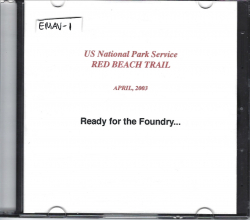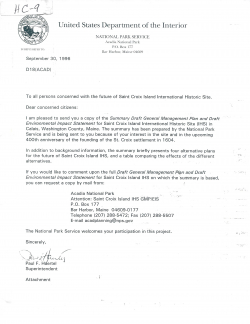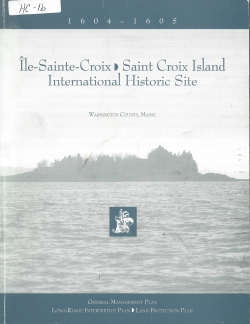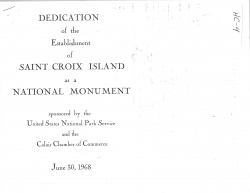The French Settlement On St. Croix Island, Maine: Excavations for the National Park Service, 1968 - 1969

Type
Publication
Authors
JWGruber ( Jacob W. Gruber )
Category
SCIWC Library
[ Browse Items ]
Publication Year
1970
Pages
221
Subject
St. Croix Island Archeological History
Tags
Abstract
Introduction
On June 30th, 1968, St. Croix island and some other properties at the nearby landing in Red Beach, Maine were dedicated as a national historical monument within the United States National Park Service and under the administrative direction of the Superintendent of Acadia National Park on Mount desert island in Maine. The inclusion of Saint Croix island within the National Park system and the immediate efforts initiated to detail and to preserve the remnants of history it contains climaxed a long campaign to bring under the care of the Park Service this valuable historical site whose occupation initiated continuous French settlement in the New World and whose discovery and establishment provided Samuel de Champlain with his first experience in that area in the subsequent exploration and colonization of which he was to become so prominent of figure. Although his later activities in the Saint Lawrence Valley are of much greater historical significance, it was on St. Croix island during the years of 1604 - 05 that he laid out his first settlement in the new world.
Although about half of the island's five or six acres had been in the possession of the federal Government as the site of the lighthouse for over a century, it was only after the discontinuance of the operation of the manually controlled light that active measures were taken to acquire the rest of the island from its private owners.
Interest in the Dochet Island as the site of Sieur de Mont’s settlement 1604 had accompanied the development of local historical interests; but it was not until the approach of the tercentenary of that ill-fated venture that such interests coalesced to produce those efforts which have led sixty-five years later to the formal measures which ensure its preservation. Much of the credit is owed Dr. William Francis Ganong. Although he served for almost forty years as professor of Botany at Smith College in Northampton, Massachusetts, he never lost his identification with New Brunswick where he was born, and where he received much of his education. Growing up in Saint Stephen, he could not avoid the development of an interest in Dochet Island with its continuing traditional association with the French who had settled on an island they called St. Croix. Ganong’s monograf in which he equates the two was published in 1902; It is still the best work on the island and on the history of the occupation by the French and their successors. So certain worthy inferences which he derived primarily from the historical and geographical sources, that, with some confidence, a plaque marking the site could be placed on a large glacial erratic on the island in an international ceremony marking the tercentenary of the settlement in 1604. During the next sixty years, there were occasional efforts to designate the island a National Historic Monument and thus prevent the destruction which was always threatened. For such efforts to succeed, that portion of the island still privately owned had to be transferred to the federal government.
In 1932, The National Park Service completed the study which formed the basis of its approval as a historical site of national importance. Three years later, Senator White of Maine attempted, but without success, to have Congress authorized the St. Croix Island as a National Monument. On June 9, 1949, The Maine Congressional delegation was able to have an act passed authorizing St. Croix Island National Monument to be established by the secretary of Interior when sufficient lands had been donated. In 1954, the long and detailed title search was initiated by volunteers on behalf of the Parker family, the principle owners, who had from the beginning sought to donate their Holdings in order to establish the Monument. With the closing of the Coast Guard portion of the island, consisting of its northern half, was transferred to the National Park Service, with the exception of a 100’ square area on which the present automatic light now stands. And finally, on September 15, 1967, the deeds to that part of the Island and acreage on the mainland directly across from it owned by the Parker family were transferred to the Federal Government and formally recorded. This transfer cleared the final obstacle to the implementation of the Act of 1949 by which the Monument was authorized. On June 30, 1968, the St. Croix island Monument was formally dedicated in ceremonies held at the landing in Red Beach. (Congressional Record, July 23, 1968, S. 9212.)
As the main speaker at that dedication , Ernest Allen Connelly , chief of the office of Archaeology and Historic Preservation of the United States Park Service announced that plans were already underway for the development of the Monument in such a way as to satisfy the legitimate interests of both the United States and Canada in its history and in its use.
“a thorough reworking of plans is presently in progress. Historical research has been underway for some time now, research that will leave unturned no document or manuscript, in this country or abroad, of possible value to the project. A phased archaeological project to last two seasons or longer will set out this year to uncover every remaining scrap of evidence beneath the surface of the ground relating to the settlement ... A Master Planning Team is at work putting the pieces together in a plan at once ambitious and practical.” (ibid., S9213)
In anticipation of the dedication, the contract (14-10-5-950-23) for the archaeological portions of the development plan was awarded Temple University with the writer as investigator in May, 1968. Field work was begun with a brief exploratory survey during the summer of 1968. This was followed by a complete season of work during the summer of 1969 during which the major part of the excavations described below was accomplished. The analysis and description of the excavation results were accomplished for the most part during the academic year of 1969 – 70. What follows is a report what follows is a report on those excavations and a discussion of the archaeological aspects of the site itself.
Although the excavations did not fulfill all of my expectations, whatever their success could not have been possible at all without the aid and cooperation of Dr. John Cotter, Regional Archaeologist of the National Park Service and John Goode, the Superintendent of Acadia National Park under whose supervision St. Croix lies. Goode Provided me with the services of Mr. Arnold Young of Red Beach who deserves special thanks for his many kindnesses throughout the season. In addition, I would particularly thank, Mr. Charles W. Tremer, my field assistant and Miss Murial Kirkpatrick of the Anthropology Laboratory of Temple University who are responsible for maps and drawings. Nor is it possible to forget our friends from the Biological Station at St. Andrews and Dr. A. A. Ruitenberg, geologist with the Department of Natural Resources in New Brunswick, all of whom provided us with hospitality, friendship and valuable information concerning the habitat then and now.
On June 30th, 1968, St. Croix island and some other properties at the nearby landing in Red Beach, Maine were dedicated as a national historical monument within the United States National Park Service and under the administrative direction of the Superintendent of Acadia National Park on Mount desert island in Maine. The inclusion of Saint Croix island within the National Park system and the immediate efforts initiated to detail and to preserve the remnants of history it contains climaxed a long campaign to bring under the care of the Park Service this valuable historical site whose occupation initiated continuous French settlement in the New World and whose discovery and establishment provided Samuel de Champlain with his first experience in that area in the subsequent exploration and colonization of which he was to become so prominent of figure. Although his later activities in the Saint Lawrence Valley are of much greater historical significance, it was on St. Croix island during the years of 1604 - 05 that he laid out his first settlement in the new world.
Although about half of the island's five or six acres had been in the possession of the federal Government as the site of the lighthouse for over a century, it was only after the discontinuance of the operation of the manually controlled light that active measures were taken to acquire the rest of the island from its private owners.
Interest in the Dochet Island as the site of Sieur de Mont’s settlement 1604 had accompanied the development of local historical interests; but it was not until the approach of the tercentenary of that ill-fated venture that such interests coalesced to produce those efforts which have led sixty-five years later to the formal measures which ensure its preservation. Much of the credit is owed Dr. William Francis Ganong. Although he served for almost forty years as professor of Botany at Smith College in Northampton, Massachusetts, he never lost his identification with New Brunswick where he was born, and where he received much of his education. Growing up in Saint Stephen, he could not avoid the development of an interest in Dochet Island with its continuing traditional association with the French who had settled on an island they called St. Croix. Ganong’s monograf in which he equates the two was published in 1902; It is still the best work on the island and on the history of the occupation by the French and their successors. So certain worthy inferences which he derived primarily from the historical and geographical sources, that, with some confidence, a plaque marking the site could be placed on a large glacial erratic on the island in an international ceremony marking the tercentenary of the settlement in 1604. During the next sixty years, there were occasional efforts to designate the island a National Historic Monument and thus prevent the destruction which was always threatened. For such efforts to succeed, that portion of the island still privately owned had to be transferred to the federal government.
In 1932, The National Park Service completed the study which formed the basis of its approval as a historical site of national importance. Three years later, Senator White of Maine attempted, but without success, to have Congress authorized the St. Croix Island as a National Monument. On June 9, 1949, The Maine Congressional delegation was able to have an act passed authorizing St. Croix Island National Monument to be established by the secretary of Interior when sufficient lands had been donated. In 1954, the long and detailed title search was initiated by volunteers on behalf of the Parker family, the principle owners, who had from the beginning sought to donate their Holdings in order to establish the Monument. With the closing of the Coast Guard portion of the island, consisting of its northern half, was transferred to the National Park Service, with the exception of a 100’ square area on which the present automatic light now stands. And finally, on September 15, 1967, the deeds to that part of the Island and acreage on the mainland directly across from it owned by the Parker family were transferred to the Federal Government and formally recorded. This transfer cleared the final obstacle to the implementation of the Act of 1949 by which the Monument was authorized. On June 30, 1968, the St. Croix island Monument was formally dedicated in ceremonies held at the landing in Red Beach. (Congressional Record, July 23, 1968, S. 9212.)
As the main speaker at that dedication , Ernest Allen Connelly , chief of the office of Archaeology and Historic Preservation of the United States Park Service announced that plans were already underway for the development of the Monument in such a way as to satisfy the legitimate interests of both the United States and Canada in its history and in its use.
“a thorough reworking of plans is presently in progress. Historical research has been underway for some time now, research that will leave unturned no document or manuscript, in this country or abroad, of possible value to the project. A phased archaeological project to last two seasons or longer will set out this year to uncover every remaining scrap of evidence beneath the surface of the ground relating to the settlement ... A Master Planning Team is at work putting the pieces together in a plan at once ambitious and practical.” (ibid., S9213)
In anticipation of the dedication, the contract (14-10-5-950-23) for the archaeological portions of the development plan was awarded Temple University with the writer as investigator in May, 1968. Field work was begun with a brief exploratory survey during the summer of 1968. This was followed by a complete season of work during the summer of 1969 during which the major part of the excavations described below was accomplished. The analysis and description of the excavation results were accomplished for the most part during the academic year of 1969 – 70. What follows is a report what follows is a report on those excavations and a discussion of the archaeological aspects of the site itself.
Although the excavations did not fulfill all of my expectations, whatever their success could not have been possible at all without the aid and cooperation of Dr. John Cotter, Regional Archaeologist of the National Park Service and John Goode, the Superintendent of Acadia National Park under whose supervision St. Croix lies. Goode Provided me with the services of Mr. Arnold Young of Red Beach who deserves special thanks for his many kindnesses throughout the season. In addition, I would particularly thank, Mr. Charles W. Tremer, my field assistant and Miss Murial Kirkpatrick of the Anthropology Laboratory of Temple University who are responsible for maps and drawings. Nor is it possible to forget our friends from the Biological Station at St. Andrews and Dr. A. A. Ruitenberg, geologist with the Department of Natural Resources in New Brunswick, all of whom provided us with hospitality, friendship and valuable information concerning the habitat then and now.
Description
A full description of the initial modern archaeological work that took place on St. Croix Island in 1968 and 1969.
Number of Copies
1
| Library | Accession No | Call No | Copy No | Edition | Location | Availability |
|---|---|---|---|---|---|---|
| SCIWC Administration | 12895 | HAR-NEW2 | 1 | Yes |




